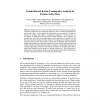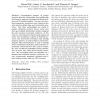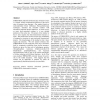105 search results - page 1 / 21 » Graph-Kernels for the Comparative Analysis of Protein Active... |
GCB
2009
Springer
13 years 8 months ago
2009
Springer
Abstract: Graphs are often used to describe and analyze the geometry and physicochemical composition of biomolecular structures, such as chemical compounds and protein active sites...
BIOCOMP
2008
13 years 6 months ago
2008
Computational analyses of protein structure-function relationships have traditionally been based on sequence homology, fold family analysis and 3D motifs/templates. Previous struct...
BMCBI
2008
13 years 4 months ago
2008
Background: Post-translational modifications have a substantial influence on the structure and functions of protein. Post-translational phosphorylation is one of the most common m...
APBC
2004
13 years 5 months ago
2004
THEMATICS (Theoretical Microscopic Titration Curves) is a simple, reliable computational predictor of the active sites of enzymes from structure. Our method, based on well-establi...
GCB
2005
Springer
13 years 10 months ago
2005
Springer
Motivation: With the increasing availability of protein structures, the generation of biologically meaningful 3D patterns from the simultaneous alignment of several protein struct...



